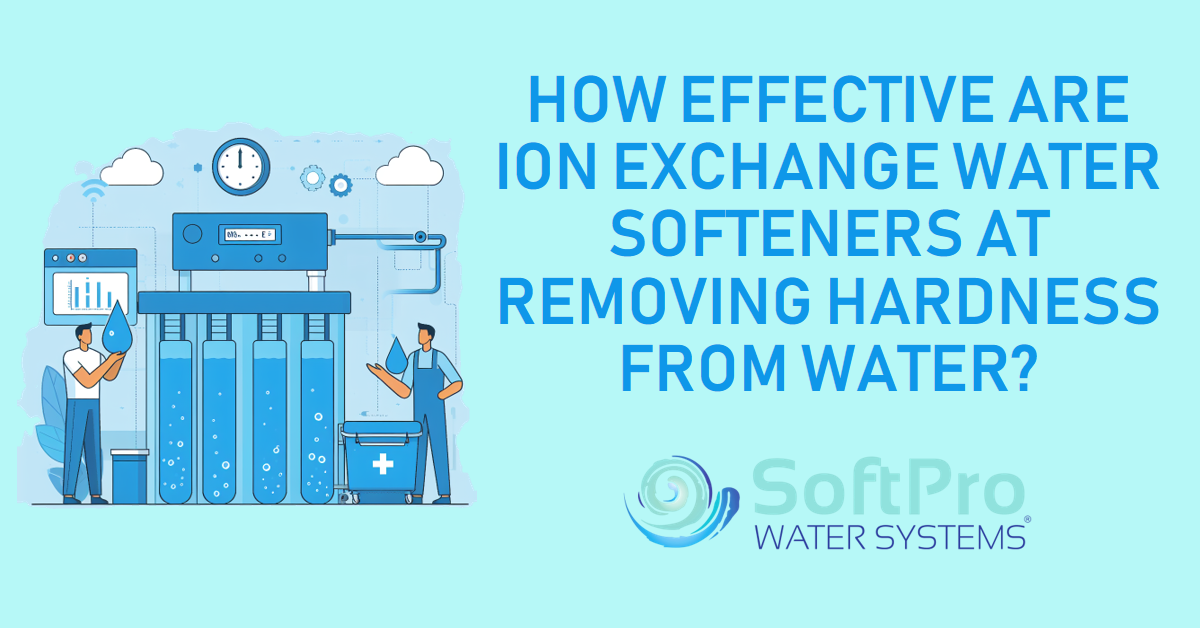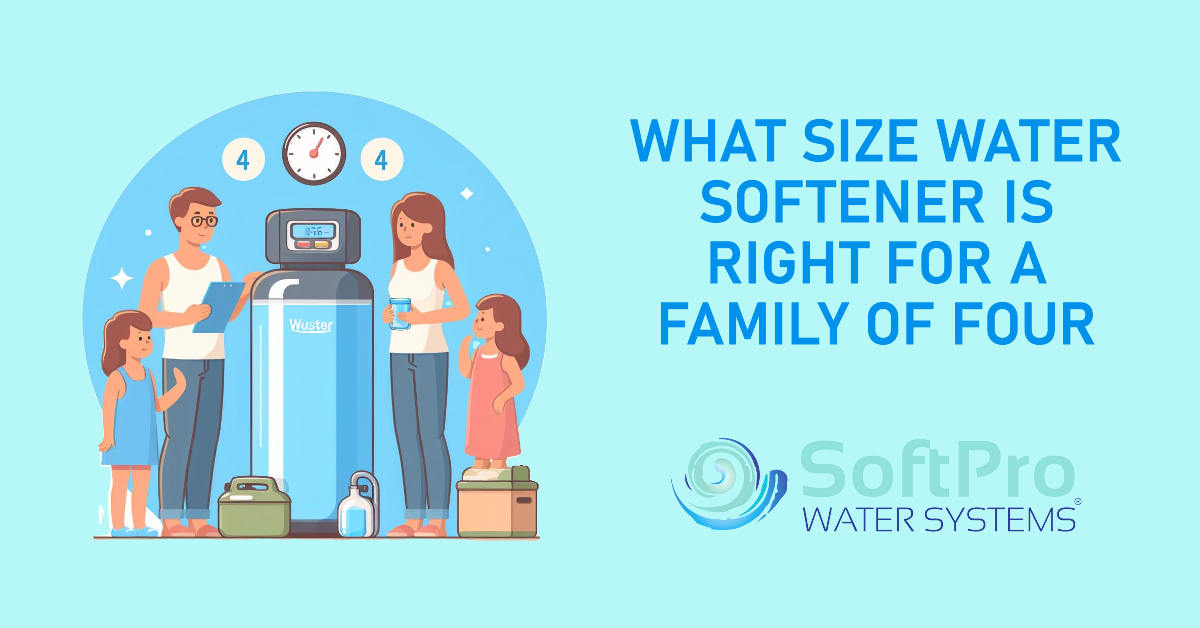How Effective Are Ion Exchange Water Softeners at Removing Hardness From Water?
Table of Contents
Ion exchange water softeners are highly effective at removing hardness from water, achieving removal rates of up to 99% for minerals like calcium and magnesium. However, their effectiveness depends on several factors, including the type and level of hardness present, the softener's capacity and flow rate, and regular maintenance.
This article delves into the specifics of ion exchange technology, its effectiveness against different types of hardness, and the factors influencing its performance. We'll also explore the drawbacks and limitations of these softeners, compare them to alternative methods, and help you choose the right softener for your needs.
Ion Exchange Water Softeners and Water Hardness
What are ion exchange water softeners and how do they work?
Ion exchange softeners using cation exchange resin utilize a cation exchange resin to remove hardness minerals, primarily calcium and magnesium, from your water. This resin is packed in a tank through which your hard water flows. Inside the tank, the following happens:
- Positive ions of calcium and magnesium (Ca2+ and Mg2+) in the hard water are attracted to the negatively charged sites on the resin beads.
- These positively charged hardness minerals dislodge sodium ions (Na+) already attached to the resin.
- The released sodium ions dissolve in the softened water, replacing the calcium and magnesium.
This process effectively reduces the hardness of your water, resulting in a number of benefits like improved cleaning efficiency, reduced scale buildup in appliances, and softer skin and hair.
What is water hardness and why is it a problem?
Water hardness refers to the mineral content, specifically the presence of calcium and magnesium. These minerals dissolve in water naturally, and their levels vary depending on your geographical location and water source. Hard water can cause several issues:
- Soap scum and scaling: Calcium and magnesium react with soap to form insoluble scum, hindering cleaning and leaving unsightly deposits on fixtures. Additionally, these minerals can build up as scale in pipes and appliances, reducing their efficiency and lifespan.
- Stiff and scratchy laundry: Hard water can make clothes feel stiff and scratchy after washing, impacting the overall feel and appearance.
- Dry skin and hair: Calcium and magnesium can strip natural oils from your skin and hair, leaving them feeling dry and irritated.
A study by the Water Quality & Health Council found that hard water costs US households an average of $241 per year in additional cleaning products, appliance repairs, and energy bills.
Measuring Ion Exchange Softener Effectiveness: Removal Efficiency and Factors
How effectively do ion exchange softeners remove hardness?
Ion exchange softeners are highly effective at removing hardness, with many models achieving removal rates of up to 99% for calcium and magnesium. This translates to significantly softer water and reduced problems associated with hard water.
A study by the Water Quality & Health Council found that ion exchange softeners reduced average water hardness by 75%, leading to improvements in cleaning, appliance performance, and skin health.
Factors affecting the effectiveness of ion exchange water softeners:
- Water hardness level: Softeners are most effective against temporary hardness, which readily exchanges with sodium ions. Permanent hardness, composed of carbonate minerals, requires higher salt concentrations and may require specialized softeners.
- Softener capacity and flow rate: The capacity of the resin tank determines how much hard water can be softened before exhaustion. Similarly, the flow rate can affect removal efficiency, with slower rates allowing for more complete exchange.
- Maintenance and regeneration: Regular refilling of salt and regeneration cycles are crucial for maintaining optimal performance. Overused or neglected softeners will experience reduced effectiveness.
A homeowner in a region with moderately hard water reported a 90% reduction in soap scum and scale buildup after installing an ion exchange softener. They also noticed softer clothes and improved skin health.
Drawbacks and Limitations of Ion Exchange Water Softeners
While highly effective, ion exchange softeners are not without drawbacks. It's essential to consider these limitations before making a decision:
Increased Sodium Levels in Softened Water: Health Considerations and Alternatives
- Sodium-Calcium Exchange: The softening process replaces calcium and magnesium with sodium, potentially increasing sodium levels in your water.
- Health Concerns: For individuals on low-sodium diets or with certain health conditions like hypertension, this rise in sodium may be a concern.
- Quote: The American Heart Association advises that most adults should limit their daily sodium intake to less than 2,300 mg. Softened water can contribute to exceeding this limit, depending on your overall dietary sodium intake.
- Alternatives: Low-sodium and salt-free water softening options exist, such as blended resin softeners or distillation methods. However, these options may come with lower efficiency or higher costs.
Maintenance Requirements and Operational Costs
- Regular Maintenance: Ion exchange softeners require regular maintenance, including salt refills, cleaning, and filter replacements.
- Cost Considerations: Salt, maintenance, and potentially increased water usage for regeneration contribute to the operational costs of these softeners.
- Quote: A study by the Water Quality & Health Council estimated the average annual cost of operating an ion exchange softener to be around $80, not including initial installation costs.
Environmental Impact of Ion Exchange Water Softeners
- Salt Discharge: Discharged brine water from softener regeneration can contribute to increased sodium levels in receiving bodies of water, potentially harming aquatic ecosystems.
- Water Usage: Regeneration cycles consume additional water, which can be a concern in regions with water scarcity.
- Quote: The Water Research Foundation estimates that water softeners can increase household water usage by 10-25%.
While drawbacks exist, the benefits of softened water often outweigh them for many households. Carefully evaluating your water hardness, health concerns, budget, and environmental considerations is crucial for making an informed decision.
Comparing Ion Exchange to Alternative Water Softening Methods
While ion exchange reigns supreme in softening effectiveness, other methods exist with their own strengths and weaknesses:
Reverse Osmosis: High Efficiency but with Additional Considerations
- Functioning: Reverse osmosis (RO) filters push pressurized water through a semipermeable membrane, trapping dissolved minerals, including hardness-causing calcium and magnesium.
- Effectiveness: SoftPro RO Filters boasts exceptional removal rates, often exceeding 99%, rendering it suitable for even the hardest water.
- Drawbacks: SoftPro RO systems waste a significant amount of water during operation, potentially doubling water usage. They also require regular membrane replacements and may have higher upfront costs compared to ion exchange.
- Quote: The Environmental Protection Agency (EPA) estimates that SoftPro RO systems waste 2-4 gallons of water for every gallon they produce.
Magnetic Water Treatment: A Controversial Alternative with Limited Effectiveness
- Claims: Magnetic water treatment devices claim to alter the physical properties of water, preventing scale buildup and potentially softening it.
- Limited Evidence: Scientific research largely debunks the effectiveness of magnetic water treatment for actually softening water. While some studies hint at potential scale reduction, the mechanisms remain unclear and inconsistent.
- Quote: A review by the Water Quality & Health Council concluded that "there is insufficient evidence to support the claims that magnetic water treatment devices soften water" and advised consumers to proceed with caution.
Other Potential Methods: Electrodescalers, Distilled Water
- Electrodescalers: These devices use electrical currents to prevent scale buildup, but their effectiveness in actual softening is limited.
- Distilled Water: Distillation effectively removes all minerals, including hardness-causing ones, but the process is energy-intensive and impractical for household water softening.
Ultimately, the best method depends on your water hardness, budget, environmental concerns, and desired level of effectiveness. Ion exchange remains a popular choice for its balance of efficacy, cost, and ease of use, while SoftPro RO Filters excels in tackling extremely hard water despite its drawbacks.
Choosing the Right Ion Exchange Water Softener: Essential Factors to Consider
Before diving into the world of soft water with an ion exchange softener, it's crucial to carefully consider your specific needs and choose the right model for optimal performance.
Assessing your water hardness level and specific needs
- Water Testing: The first step is to get your water tested to determine the level and type of hardness present. This will help you choose a softener with the appropriate capacity and features.The Water Quality & Health Council recommends water testing through certified laboratories or home test kits to accurately assess your water hardness.
- Consider Specific Needs: Think about your household water usage patterns, appliance susceptibility to hard water (dishwashers, washing machines), and any specific concerns like skin sensitivity.
Selecting the appropriate softener capacity and flow rate
- Capacity: The softener's grain capacity indicates its ability to remove hardness before requiring regeneration. Choose a capacity that matches your average daily water usage and hardness level.
- Flow Rate: Ensure the softener's flow rate can handle your peak water demand to avoid pressure drops or compromised performance.
The Water Quality & Health Council provides a helpful chart to estimate softener capacity based on household size and water hardness. Generally, aim for a capacity exceeding your daily water usage by 25-50%.
Evaluating additional features and considerations
- Automatic Regeneration: Opt for softeners with automatic regeneration for convenience and consistent performance.
- Bypass Valve: A bypass valve allows you to temporarily bypass the softener for maintenance or if soft water isn't needed.
- Water Efficiency Certifications: Look for models with WaterSense certification to minimize water usage during regeneration.
- Installation Options: Consider professional installation for complex systems or if DIY plumbing isn't your forte.
- Warranty and Maintenance Costs: Choose a softener with a good warranty and factor in ongoing maintenance costs for salt, cleaning, and filter replacements.
For example, a family of four in a moderately hard water region chose a 40,000-grain capacity softener with automatic regeneration based on their water usage and appliance needs. This provided them with soft water while keeping maintenance and costs manageable.
Real-world Experiences and User Insights: Reviews, Pros, and Cons
With any home improvement choice, understanding real-world experiences is crucial. Let's explore what existing ion exchange water softener users have to say:
Exploring customer reviews and feedback on ion exchange water softeners:
Pros:
- Improved cleaning: Many users report a significant reduction in soap scum and scale buildup on dishes, sinks, and appliances, making cleaning easier and more effective.
- Enhanced appliance performance: Softened water can extend the lifespan of dishwashers, washing machines, and other appliances by preventing scale buildup and corrosion.
- Softer skin and hair: Users often mention improved skin and hair texture due to the removal of harsh minerals, especially beneficial for those with sensitive skin.
- Reduced water usage: In some cases, softened water can help decrease overall water usage by improving soap and detergent effectiveness, leading to shorter cleaning cycles.
Cons:
- Maintenance needs: Regular refilling of salt and potential filter replacements can be a hassle for some users.
- Increased sodium levels: For individuals on low-sodium diets, the rise in sodium content may be a concern.
- Initial cost and installation: The upfront cost of purchasing and installing a softener can be a barrier for some households.
- Water wastage during regeneration: Regeneration cycles use additional water, which can be a concern in regions with water scarcity.
A Consumer Reports survey found that 88% of water softener owners were satisfied with their purchase, highlighting the overall positive experiences with these systems.
Addressing specific concerns and challenges faced by users:
- Salt alternatives: Low-sodium and salt-free softener options are available, although they may come with lower efficiency or higher costs.
- Water conservation: WaterSense-certified softeners minimize water usage during regeneration, and alternative methods like demand-initiated regeneration can further optimize water consumption.
- Maintenance tips: Regular cleaning and proper regeneration settings can extend the lifespan of filters and reduce maintenance frequency.
While some drawbacks exist, user feedback overwhelmingly supports the benefits of ion exchange water softeners for improved cleaning, appliance longevity, and personal comfort. Carefully considering your needs and choosing the right system can help mitigate potential concerns and reap the rewards of soft water.
Conclusion: Soft Water Solutions for Every Home
So, how effective are ion exchange water softeners? The answer is a resounding highly effective, achieving removal rates of up to 99% for hardness minerals like calcium and magnesium. However, their effectiveness hinges on factors like water hardness level, softener capacity, and regular maintenance.
This comprehensive guide has delved into the nitty-gritty of ion exchange technology, exploring its strengths and weaknesses, and providing real-world insights to help you make an informed decision.
Key takeaways:
- Effectiveness: Ion exchange softeners are powerhouses against hardness, drastically reducing soap scum, scale buildup, and improving appliance performance.
- Drawbacks: Increased sodium levels, maintenance needs, and potential water waste during regeneration require careful consideration.
- Choosing the right softener: Assess your water hardness, capacity needs, and budget to find the perfect fit for your home.
- Alternatives: Reverse osmosis excels in hard water regions, while magnetic and other methods require research due to limited scientific evidence.
Remember: Soft water isn't just about fluffy towels and sparkling dishes; it can extend appliance lifespan, improve cleaning efficiency, and even benefit skin and hair health. By weighing the pros and cons and choosing the right system, you can unlock the doors to a softer, smoother water experience in your home.




![SoftPro Chlorine+ Carbon Whole House Water Filter to Remove PFAS, Chlorine, Chloramine & Pesticides [City Water Filters Series]](http://www.softprowatersystems.com/cdn/shop/products/softpro-whole-house-chlorine-filter-282008.jpg?v=1758858973&width=140)
![SoftPro Iron Filter - Iron Master AIO - Best Iron Filter for Well Water [Air Injected Water Filter / Katalox]](http://www.softprowatersystems.com/cdn/shop/products/softpro-iron-master-aio-water-filtration-system-remove-iron-sulfur-manganese-using-air-injection-for-optimal-performance-412868.jpg?v=1758859831&width=140)













